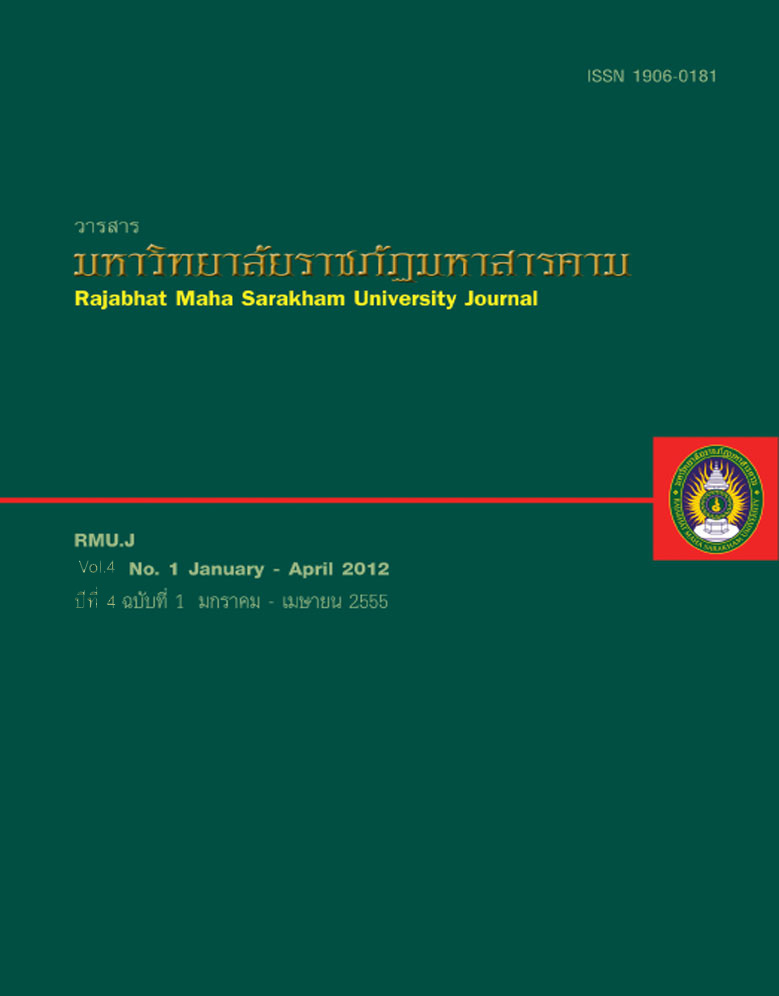การพัฒนารูปแบบการฝึกอบรมครูสอนภาษาอังกฤษแบบค่ายกิจกรรม Development of Activity-Based Training Camp Model for English Teachers
Main Article Content
บทคัดย่อ
การวิจัยครั้งนี้มีวัตถุประสงค์เพื่อพัฒนาและหาประสิทธิภาพของรูปแบบการฝึกอบรมครูสอนภาษาอังกฤษแบบค่ายกิจกรรม ซึ่งการประเมินผลโดยยึดรูปแบบการประเมินตามแบบ CIPP model ของแดลเนียล แอล สตัฟเฟิลบีม
ผลการวิจัยพบว่า
1. การประเมินสภาวะแวดล้อม วัตถุประสงค์ของการฝึกอบรมคือ เพื่อให้ผู้เข้าร่วมฝึกอบรมมีความรู้ ทักษะ และเจตคติที่ดีในการสอนภาษาอังกฤษช่วงชั้นที่ 1-2 ระยะเวลา 3 วัน โดยมีวิทยากรอบรม ให้ความรู้ทั้งภาคทฤษฎีและปฏิบัติ จำนวน
3 หัวข้อ ได้แก่ กิจกรรมการแบ่งกลุ่มผลสัมฤทธิ์ กิจกรรมการแข่งระหว่างกลุ่มด้วยเกม และกิจกรรมวอล์คแรลลี่ นอกจากนี้ผู้เชี่ยวชาญทำการประเมินความสอดคล้องทั้ง 9 หัวข้อพบว่า มีความสอดคล้องในระดับสูง ซึ่งแสดงให้เห็นว่าชุดฝึกอบรมนี้
สามารถนำไปใช้ฝึกอบรมได้
2. การประเมินปัจจัยเบื้องต้นโดยทดลองใช้ผลปรากฏว่า คะแนนภาพรวมของผลสัมฤทธิ์การทำใบงานและใบทดสอบมีค่าเฉลี่ย 83.95 และ 81.81
3. การประเมินกระบวนการ โดยการนำชุดฝึกอบรมมาปรับปรุงและแก้ไข จึงนำไปเก็บรวบรวมข้อมูล พบว่ามีประสิทธิภาพมีค่าเฉลี่ย 87.32 / 83.83 ซึ่งถือว่าสูงกว่าเกณฑ์ 80/80 ที่ตั้งไว้
4. การประเมินผลผลิต โดยการประเมินผลคะแนนจากใบทดสอบความรู้ การปฏิบัติการนิเทศการสอนทฤษฎีและปฏิบัติของครูผู้สอน ความคิดเห็นของผู้เรียน พบว่าทุกรายการอยู่ในระดับดี
This research aimed to develop an Activity-Based Training Camp Model for English Teachers
and find its efficiency indexes based on the CIPP Model of Daniel L. Stufflebeam. Findings can be
summarized as follow: 1) Context Evaluation of this training model indicated that the objectives were for
trainees to gain knowledge and skills as well as positive attitude toward English teaching of level 1-2,
and they would be trained in both theory and practice in a 3-day training through use of three camp
activities: Student Teams Achievement Division, Team Games Tournament, and Walk Rally; and
content validity of the training model, which was assessed by 7 specialists to determine index of itemobjective
congruence of 9 items, was found at the high level; indicating that the training model can be
implemented with actual training. 2) Input evaluation was assessed by trying out this model which
revealed that the overall averages of scores on work sheets and achievement test were 83.95/81.81. 3)
Process evaluation was conducted by modifying and further improving the model before implementing
it. Results of the implementation revealed that the efficiency indexes were 87.32/83.83, which were
higher than the established criteria of 80/80; and 4) Product evaluation was conducted by assessing
students’ performance on test papers, supervising subjects’ teaching in both theory and practice, and
studying students’ satisfaction. Results of product evaluation revealed a high level of all these areas.
Article Details
1. บทความที่ลงตีพิมพ์ทุกเรื่องได้รับการตรวจทางวิชาการโดยผู้ประเมินอิสระ ผู้ทรงคุณวุฒิ (Peer Review) สาขาที่เกี่ยวข้อง อย่างน้อย 3 ท่าน ในรูปแบบ Double blind review
2. ข้อคิดเห็นใด ๆ ของบทความที่ลงตีพิมพ์ในวารสารมหาวิทยาลัยราชภัฏมหาสารคาม นี้เป็นของผู้เขียน คณะผู้จัดทำวารสารไม่จำเป็นต้องเห็นด้วย
3. กองบรรณาธิการวารสารมหาวิทยาลัยราชภัฏมหาสารคาม ไม่สงวนสิทธิ์การคัดลอกแต่ให้อ้างอิงแสดงที่มา


